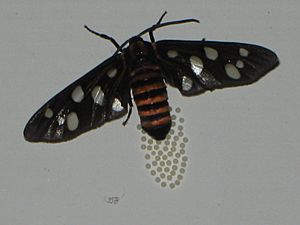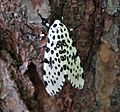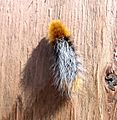Arctiidae facts for kids
Quick facts for kids Arctiidae |
|
|---|---|
 |
|
| Harnessed Tiger Moth Apantesis phalerata |
|
| Scientific classification | |
| Kingdom: | |
| Phylum: | |
| Class: | |
| Order: | |
| Suborder: | |
| Superfamily: |
Noctuoidea
|
| Family: |
Arctiidae
Leach, 1815
|
| Type species | |
| Arctia caja Linnaeus, 1758
|
|
| Subfamilies | |
|
Arctiinae |
|
| Diversity | |
| 1,400-1,500 genera Approximately 11,000 species |
|
Arctiidae is a large family of moths. There are about 11,000 different kinds of these moths found all over the world. This group includes moths commonly called tiger moths.
Tiger moths often have bright colors. Other types in this family are footmen, which are usually duller, and wasp moths. Many of their caterpillars are very 'hairy'. These are often called woolly bears or woolly worms. The scientific name "Arctiidae" comes from a Greek word meaning "bear," because of these hairy caterpillars.
Contents
About Tiger Moths
Tiger moths have special body parts that help them. They have an organ called a tymbal organ on their chest. This organ makes super high-pitched sounds, called ultrasonic sounds. They also have special 'ears' on their chest to hear these sounds.
These sounds help them find mates. They also use the sounds to protect themselves from animals that want to eat them. Their caterpillars are known for having many 'hairs' or bristles. Female moths also have special glands near where they lay eggs.
Bright Colors and Defenses
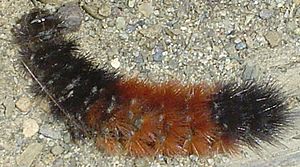
Many tiger moths and their caterpillars have ways to protect themselves. They can get bad-tasting or poisonous chemicals from the plants they eat. Some species can even make their own defenses. These defenses can include chemicals like cardiac glycosides or histamines.
Caterpillars usually get these chemicals from plants. They can keep them even when they become adult moths. Adult moths can also get these chemicals by drinking fluids from rotting plants. Male moths can even pass these defenses to females to help protect their eggs. Some caterpillars have stinging hairs because of chemicals they make.
These insects often show off their defenses with warning colors. This is called aposematism. They use bright colors, strange body positions, or smells to warn predators. Adult moths can also make ultrasonic sounds to warn off predators. Some tiger moths even look like other poisonous moths or stinging wasps. The ultrasound signals help animals like bats learn to avoid them. For some species, these sounds can even block bat echolocation.
Life and Habits
Many tiger moth caterpillars and adults are active during the day. However, most kinds of tiger moths fly at night. Moths are often drawn to lights. But one species, Borearctia menetriesii, never comes to light.
Caterpillars often bask in the sun to help them digest their food. They can live alone or in groups. Like most moths and butterflies, caterpillars make a small silk pad before they shed their skin. They use this pad to hold on during the molt.
If a woolly bear caterpillar is bothered, it will roll into a tight ball. Or it might drop from its perch while hanging by a silk thread. Isabella tiger moths (Pyrrharctia isabella) spend the winter as caterpillars. They can survive freezing temperatures. They do this by making a special chemical that protects them from ice. Another species, Phragmatobia fuliginosa, can even be seen on snow looking for a place to turn into a pupa. Moths in cold areas spend the winter as caterpillars.
Some tiger moths make ultrasonic clicks when bats use echolocation. This helps them protect themselves from the bats. Even though there are many tiger moths, only a few cause problems for people or crops. For example, the fall webworm eats many different trees. It has spread from North America to Asia and Europe. But it usually doesn't cause lasting harm to healthy trees.
Woolly Bear Folklore
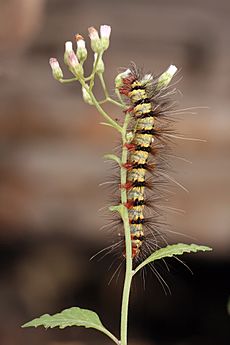
In parts of the American Northeast and South, there is a popular belief. People say that "woolly bears" can help predict the winter weather. This is similar to the idea of the groundhog. The amount of black on the Isabella tiger moth's caterpillar is said to show how harsh the winter will be.
If the caterpillar has more brown than black, it supposedly means a mild winter. If it has more black than brown, it means a harsh winter. However, the amount of black actually changes as the caterpillar grows. It does not depend on the weather. This fun belief has led to festivals. These include the Woollybear Festival in Ohio and the Wooly Worm Festival in Beattyville, Kentucky. There is also a Wooly Worm Festival in Banner Elk, North Carolina.
Images for kids
-
Final instar of Euchaetes egle
See also
 In Spanish: Arctinos para niños
In Spanish: Arctinos para niños


